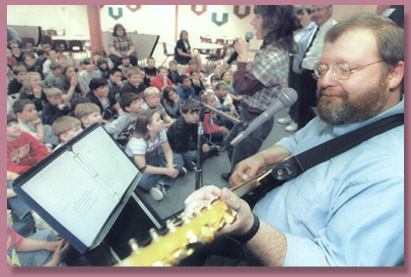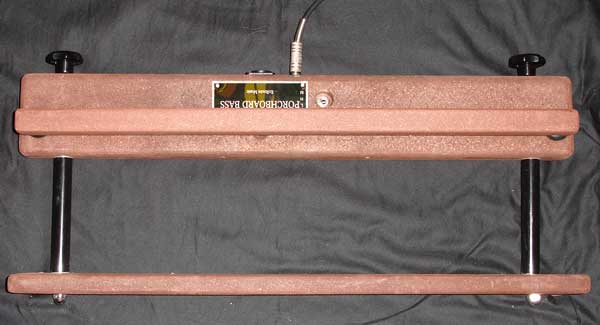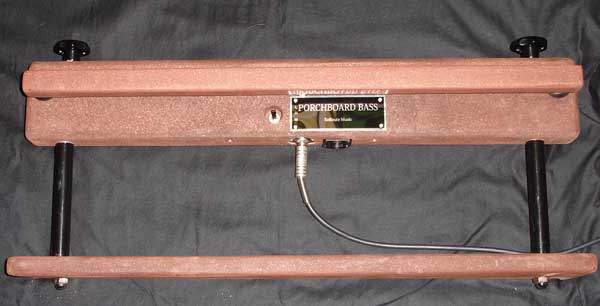Difference between revisions of "PorchBoard Floor Bass"
m (rewrites for new model, added references) |
m (→Playing the PorchBoard through the L1®: formatting) |
||
| Line 26: | Line 26: | ||
== Playing the PorchBoard through the L1® == | == Playing the PorchBoard through the L1® == | ||
| − | Like any instrument, when you spend some time with it you can get different effects and be more expressive with it as you learn | + | Like any instrument, when you spend some time with it you can get different effects and be more expressive with it as you learn its capabilities & limitations . |
| − | * | + | * With the new model, there is a shorter sensor rail and more consistent sound across the length. With older models you could get more variation of volume depending on where you placed your foot. With the newer model, you can moderate the volume by how hard you tap with your foot. |
* While sitting ''(which makes it *much* easier to use both feet!)'', I found it effective to place one foot over one end of the tap rail (over the support on one end) while the other foot did the tapping at various places. This acted something like a "damper" pedal/muffler, allowing me more control over how quietly I could 'tap'. | * While sitting ''(which makes it *much* easier to use both feet!)'', I found it effective to place one foot over one end of the tap rail (over the support on one end) while the other foot did the tapping at various places. This acted something like a "damper" pedal/muffler, allowing me more control over how quietly I could 'tap'. | ||
| Line 36: | Line 36: | ||
** quick-tap-and-get-the-foot-off-as-fast-as-you-can. | ** quick-tap-and-get-the-foot-off-as-fast-as-you-can. | ||
| − | * There's no reason to just tap with just the toe or ball of your foot. You can also turn it around to place the | + | * There's no reason to just tap with just the toe or ball of your foot. You can also turn it around to place the toe rail (the one with the pickup under it) under your heel, so you tap by raising your heel rather than the toe. In a lot of ways that is often a more comfortable position for me when I'm playing the keyboard (raising the heel rather than the toe). Besides that, it uses different muscles -- so when my leg is getting a bit tired, I'll sometimes turn the PorchBoard around before the next song. |
| − | |||
| − | |||
| − | |||
| − | |||
* Unlike an acoustic kick drum, or most other large drums, the PorchBoard seems to have few strong higher harmonics; for example, turning the High EQ way down seems to have little effect on the resulting sound. <br />There is a three way switch | * Unlike an acoustic kick drum, or most other large drums, the PorchBoard seems to have few strong higher harmonics; for example, turning the High EQ way down seems to have little effect on the resulting sound. <br />There is a three way switch | ||
| Line 49: | Line 45: | ||
* It is designed to produce a tone in the 33-100 Hz range (very low). The 33 Hz (with a strong 99 Hz harmonic) was selected because it offers a strong supportive bass "thump" in any key- similar to a large marching band bass drum. Often the nature of the sound tends to resemble a note when another instrument (such as a guitar) suggests a note. <ref>Nature of the sound.... [http://porchboard.com/FAQ01.html - excerpt from the PorchBoard FAQs]</ref> | * It is designed to produce a tone in the 33-100 Hz range (very low). The 33 Hz (with a strong 99 Hz harmonic) was selected because it offers a strong supportive bass "thump" in any key- similar to a large marching band bass drum. Often the nature of the sound tends to resemble a note when another instrument (such as a guitar) suggests a note. <ref>Nature of the sound.... [http://porchboard.com/FAQ01.html - excerpt from the PorchBoard FAQs]</ref> | ||
| − | * Since the PorchBoard produces predominately low-end sounds it is subject to the same issues that can arise with any instrument that works in the low bass ranges. See: [[Bass Regeneration]] for more information. Because the PorchBoard does not make any audible acoustic sound, and it does not use a resonant surface<ref>the PorchBoard does not use a resonant surface for pickkup [http://porchboard.com/FAQ02.html PorchBoard FAQs] to pickup the sound, it does not contribute to low end feedback in a live music setting. | + | * Since the PorchBoard produces predominately low-end sounds it is subject to the same issues that can arise with any instrument that works in the low bass ranges. See: [[Bass Regeneration]] for more information. <br />Because the PorchBoard does not make any audible acoustic sound, and it does not use a resonant surface<ref>the PorchBoard does not use a resonant surface for pickkup [http://porchboard.com/FAQ02.html PorchBoard FAQs] to pickup the sound, it does not contribute to low end feedback in a live music setting. |
* When using the PorchBoard with a {{Classic}} or {{Model I}} use at least one {{B1}} as you would with any instrument that plays bass notes. The sound of the PorchBoard comes through well with the {{Compact}} but sounds deeper with the {{L1 nl}} models that have a {{B1}}. | * When using the PorchBoard with a {{Classic}} or {{Model I}} use at least one {{B1}} as you would with any instrument that plays bass notes. The sound of the PorchBoard comes through well with the {{Compact}} but sounds deeper with the {{L1 nl}} models that have a {{B1}}. | ||
| Line 56: | Line 52: | ||
* The new RP model PorchBoard has metal shielding around the sensor making it less susceptible to RF noise than earlier models. | * The new RP model PorchBoard has metal shielding around the sensor making it less susceptible to RF noise than earlier models. | ||
| + | |||
| + | * The following notes are most applicable to the older solid wood model of the Porchboard | ||
| + | ** One can get '''really''' quiet taps by tapping on the heel rail (back), rather than the toe rail; that is, tap so the vibration goes through the whole board to the pickup, rather than tapping on the "tap-rail" itself ''(which is directly over the pickup)''. | ||
| + | ** The most interesting range of effects is possible when the gain is high enough that you have to tap softly most of the time. Besides that, it's a lot easier on the leg when you can minimize the effort involved in playing it. Yeah, it'll often "flash red" at those higher gains if you then '''stomp''' on the PorchBoard, but the associated distortion can ''(judiciously applied)'' have it's own place. Besides, why should guitarists be the only ones who have fun with deliberate distortion?!?! <br />''(Of course, for those of you who have seen Cliff Henricksen play the keyboard, if one stuck the PorchBoard under *his* foot you'd have to turn the gain waaaayyyy down! -- come to think of it, you'd really need two in order to stick one under each foot!)'' | ||
</td><td valign="top"> | </td><td valign="top"> | ||
Revision as of 13:38, 18 February 2010
ContentsMusical Instrument (Percussion)The PorchBoard Floor Bass is a simple percussion instrument designed to be tapped by a foot to provide a "kick drum"-like sound. It could be classed as an instrument of indefinite pitch containing complex frequencies through which no discernible pitch can be heard.[1] With very little audible sound by itself, the internal pickup provides both 1/4" and XLR output connections that may be used simultaneously.
Settings on the L1® for the PorchBoardT1 ToneMatch® Audio EngineYou can run the PorchBoard into T1® Channel 4 or 5, completely flat, no effects. While you could use T1® Channels 1, 2, or 3, there is no need to do that, so you can leave 1, 2, and 3 available for other inputs that require more gain. The ToneMatch® settings are
L1 Classic or L1 Model IOn a L1 Classic or L1 Model I, you may use Power Stand Channel 3 or 4. L1 Model IIYou can also run the PorchBoard directly to a L1 Model II Power Stand Analog input. You would use the Analog trim to control the volume. If you don't mind doing that, this leaves another input on the T1 ToneMatch Audio Engine available. L1 CompactThe PorchBoard works well with the L1 Compact. If you are not using Channel 2 for a different instrument then run the PorchBoard ¼ inch output to Compact Channel 2 - ¼ inch input. If you are using Channel 2 for Guitar or other instrument then you can run the PorchBoard to one of the Channel 2 RCA jacks using a ¼ inch to RCA adapter or cable. Playing the PorchBoard through the L1®Like any instrument, when you spend some time with it you can get different effects and be more expressive with it as you learn its capabilities & limitations .
|
{{#Click:http://porchboard.com/RP.html%7CImage:RP PorchBoardFront.jpg|325px|PorchBoard Bass - new model "RP" 2010}} {{#Click:http://porchboard.com/FAQ03.html%7CImage:PorchBoardDeanDwyer.jpg%7C325px%7CDean Dwyer holding the original model Mahogany PorchBoard Floor Bass}} See / Hear it
Where it came from and how it works. Discussions about the PorchBoard
Enroute Music
TechnologyProximity SensorFrom the PorchBoard website:
Added notes from Bill
BackgroundNotes from Nadene Isackson
|
The Instrument
General Description
- constructed using durable composites (reclaimed plastics an recycled wood Trex)
- features XLR and 1/4" outputs
- passive - no batteries or additional power sources are required.
- no noise, feedback or delay
- disassembles for compact travel (no tools required)
- includes a handy carry bag
PorchBoard Floor Bass UCL-S (discontinued in 2010)
Instructions
This is included here because it gives insight into the different models. From the PorchBoard site
The PorchBoard Bass plugs directly into an amplification system (set up much like a bass guitar would be.)using a quarter-quarter guitar cord or an XLR cord (or both simultaneously). No additional power sources or batteries are required.
Beginning tapping (heel on heel rail and toe on suspended toe rail) with a very simple beat, tapping once or twice each measure. With a little practice you will develop your own style and rhythm and your PorchBoard playing will become automatic.
Adjust the amplifier controls for tone and adequate volume. We suggest using a maximum setting on the low end (bass) control and then adjust the volume control so that a good sound is achieved with minimum tapping effort. Extreme tapping efforts are not necessary.
The PorchBoard is designed to produce a tone in the 33-100 HZ range (very low). The 33 HZ (with a strong 99 HZ harmonic) was selected because it offers a strong supportive bass "thump" in any key- similar to a large marching band bass drum. Often the nature of the sound tends to resemble a note when another instrument (such as a guitar) suggests a note.
Excellent results can be obtained by using a quality bass amp, keyboard amp, capable PA system, powered subwoofer (the PorchBoard has adequate output to drive most powered subwoofers without the use of a pre-amp or any amplification system) that can reproduce these low frequencies at adequate levels.
The PorchBoard has a three way frequency response switch designed to match the frequency range of an increased number of amplifiers with higher frequency sound capability. The L (low) setting allows the very low bass, perfect for subwoofer or quality bass amp usage. The M (mix) setting filters a mix of low and high frequencies, and the H (high) setting provides for high end, stompbox slap.
Alternate Assembly
The following pictures are viewed from the player's perspective.
Normal
This is the way you usually assemble a PorchBoard.
Reversed
Try assembling your PorchBoard like this and the connectors will be protected. This takes a little less floor space. Just disassemble the PorchBoard, rotate the large section 180° and reassemble. The distance between the heel rail and the sensor rail is about 3/4" longer when you do this.
- ↑ Wikipedia Wikipedia/Percussion Instrument#indefinite pitch
- ↑ Nature of the sound.... - excerpt from the PorchBoard FAQs


